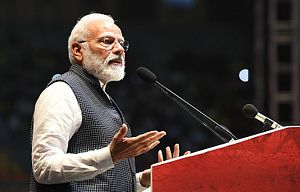The recent clashes at the Sino-India border have made the power differential between China and India painfully clear. China has occupied Indian territory and killed 20 soldiers, and the extent of India’s response has been to ban some Chinese tech products. In the absence of a vastly larger Indian economy, Chinese regional dominance of this sort is virtually assured. This imbalance should be the wake-up call for America to make India’s economic growth the cornerstone of its Indo-Pacific strategy.
When China launched its reforms in 1978, its economy was $10 billion bigger than India’s. Today, it is $10.9 trillion bigger. In the intervening period, Chinese annual growth averaged 9.5 percent, versus 5.8 percent for India. This allowed Chinese military spending to increase by over 10 times between 1989 and 2019, compared to less than four for India. China is flexing its new economic and military muscle by bullying its neighbors and internal enemies: consider the Indian border clashes, cyberattacks against Australia, the internment of Uyghur Muslims, and its expansion in the South China Sea. In whole, China’s growth drastically altered the global distribution of power.
Whether looking at the situation from Washington or Delhi, it’s clear that limiting Chinese dominance in the Indo-Pacific may well depend on the ability of India’s economy to grow significantly over a long period of time. India is the only emerging market with the manpower and size to rival China’s economy, while its geography and history position it as a natural bulwark against Chinese aggression. Securing this economic growth needs to be a priority of each country’s defense and business communities. Prolonged Indian growth could buttress democracy globally, just as Chinese growth emboldened authoritarianism.
Unfortunately, India’s economic outlook is bleak. From the peak of optimism when Narendra Modi became prime minister in 2014, the Indian economy has continually underperformed. While visiting Silicon Valley in 2015, Modi declared the 21st would be India’s century. Five years later, many economists and observers worry this century may be a lost one for India.
Despite being elected with sweeping, pro-growth mandates in both 2014 and 2019, Modi’s BJP government failed to enact meaningful reform. The government has failed to privatize its hulking state-owned enterprises. Foreign ownership of domestic firms remains tightly regulated. Convoluted land and labor laws still impede business growth. The World Bank described a supposedly revolutionary value added tax as one of the world’s most complex. Modi’s 2016 demonetization policy likely shaved several points off growth. By 2019, India began suffering systemic economic slowdown as national consumption and investment bottomed out. Growth rates plummeted to 42 year lows before COVID-19 struck; the pandemic shattered whatever was left.
Goldman Sachs now projects the economy to contract by 5 percent for fiscal year 2020. While Modi announced a $265 billion coronavirus stimulus – equivalent to 10 percent GDP – economists have put the package’s true value at closer to 1.5 percent of GDP. The accelerating spread of the virus across India has the potential to generate staggering economic costs.
Despite all of this, there is reason for optimism. In short, necessity is the mother of reform. India only opened its economy and launched its reform agenda in 1991 because its economic situation was so dire. Facing sovereign default, it had no choice but to systemically reform its economy. With the economy cratering while tens of millions of young Indians enter the workforce for years to come, the necessity, and therefore likelihood, of reform will increase. Already, to combat 26 percent unemployment at the height of India’s lockdown, Indian states gutted longstanding labor regulations, and momentum is increasing for land reform.
The United States should strongly encourage India’s domestic economic reforms. India can only be a bulwark against China if it has the economic heft to sustain it. Achieving this can involve traditional carrots and sticks from the United States, but policymakers should seek creativity and ambition in policy design. The present moment offers unmatched potential for U.S.-India synergy across strategic alignment, economic prosperity, and democratic cause – U.S. policymakers must take full advantage of this. They must also make clear that American interest in the economic relationship is not solely for the benefit of US companies, but rather for all countries wary of Chinese expansionism and aggression, including India itself.
Indian growth is key to countering Chinese aggression. As the border standoff showed, the current economic gap between China and its neighbors permits Beijing to act with impunity. A strong Indian economy is therefore critical to both Indian and American security. Both must cooperate to grow the Indian economy, and each will find strength in the other to protect their common interests.
Max Frost is a Senior Research Associate and Michael Sauer is a Research Intern at the American Enterprise Institute.

































